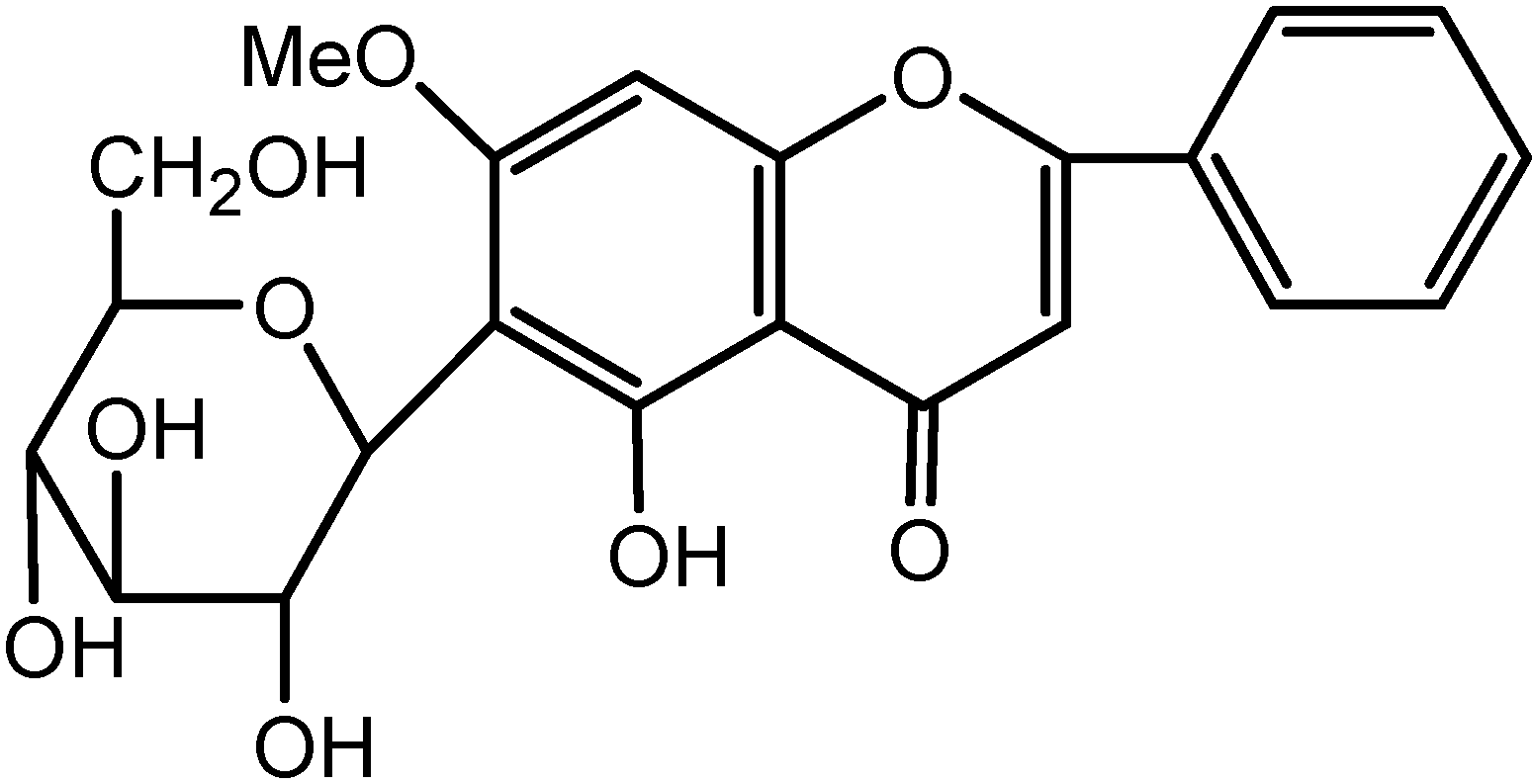A Novel Flavonoid C-glycoside from Sphaeranthus indicus L. (Family Compositae)
Abstract
:Introduction
Results and Discussion

Experimental
General
Plant material and product isolation
Acknowledgments
References
- Kirtikar, K.R.; Basu, B.D. Indian Medicinal Plants; Lalit Mohan Basu: Allahabad, India, 1935; II; p. 1346. [Google Scholar]
- Sadaf, F.; Saleem, R.; Ahmed, M.; Ahmad, S. I.; Zafar, N. Healing potential of cream containing extract of Sphaeranthus indicus on dermal wounds in Guinea pigs. J. Ethnopharmacol. 2006, 107, 161–163. [Google Scholar] [CrossRef]
- Ambavade, S. D.; Mhetre, N. A.; Tate, V. D.; Bodhankar, S. L. Pharmacological evaluation of the extracts of Sphaeranthus indicus flowers on anxiolytic activity in mice. Indian J. Pharmacol. 2006, 38, 254–259. [Google Scholar] [CrossRef]
- Nisha, M.; Kalyanasundaram, M.; Paily, K. P.; Abidha; Vanamail, P.; Balaraman, K. In vitro screening of medicinal plant extracts for macrofilaricidal activity. Parasitol. Res. 2007, 100, 3. 575–579. [Google Scholar]
- Ram, A. J.; Bhakshu, L. M.; Raju, R. R. V. In vitro antimicrobial activity of certain medicinal plants from Eastern Ghats, India, used for skin diseases. J. Ethnopharmacol. 2004, 90, 353–357. [Google Scholar] [CrossRef]
- Srinivasan, D.; Nadarajan, L. Wet land weeds Sphaeranthus indicus Asteraceae (Linn.) a potential green pesticide for managing Angoumois grain moth Sitotroga cerealella (Oliv.). Resist. Pest Manag. 2006, 16, 1. 21–25. [Google Scholar]
- Pujar, P. P.; Sawaikar, D. D.; Rojatkar, S. R.; Nagasampagi, B. A. Eudesmanoids from Sphaeranthus indicus. Fitoterapia 2000, 3, 264–268. [Google Scholar]
- Gogte, M. G.; Ananthasubramanian, L.; Nargund, K. S.; Bhattacharya, S. C. Some interesting sesquiterpenoids from Sphaeranthus indicus Linn. Indian J. Chem. 1986, 25, 233–238. [Google Scholar]
- Sohoni, J. S.; Rojatkar, S. R.; Kulkarhni, M. M.; Dhaneshwar, H. N.; Tavale, S. S.; Gururow, T. N.; Nagasampagi, B. A. A new eudesmenolide & 2-hydroxycostic acid from Sphaeranthus indicus linn. X-Ray molecular structure of 4α, 5α-epoxy-7α-hydroxyeudesmanolide. J. Chem. Soc.Perkin Trans I. 1988, 157–160. [Google Scholar]
- Markham, K. R. Techniques of Flavonoids Identification; Academic Press: London, 1982; Chapter 3; pp. 36–51. [Google Scholar]
- Mabry, T. J.; Markham, K. R.; Thomas, M. B. The Systematic Identification of Flavonoids; Springer: Berlin, 1970; pp. 35–250. [Google Scholar]
- Markham, K. R.; Ternai, B.; Stanly, R.; Geiger, H.; Mabry, T.J. Carbon-13 NMR studies of flavonoids- III. Tetrahedron 1978, 34, 1389–1397. [Google Scholar] [CrossRef]
- Harbone, J. B. The Flavonoids. Advances in Research; Jay, M., Ed.; Chapman and Hall: London, New York, 1986; Chapter 3; pp. 57–87. [Google Scholar]
- Komatsu, M.; Tomimori, T.; Makiguchi, Y. Studies on the constituents of Swertia japonica, II. Isolation and structure of new flavonoid, swertia japonin. Chem. Pharm. Bull. 1967, 15, 1567–1572. [Google Scholar] [CrossRef]
- Sample availability: Contact the Author.
© 2007 by MDPI (http://www.mdpi.org). Reproduction is permitted for noncommercial purposes.
Share and Cite
Mishra, B.B.; Yadav, S.B.; Singh, R.K.; Tripathi, V. A Novel Flavonoid C-glycoside from Sphaeranthus indicus L. (Family Compositae). Molecules 2007, 12, 2288-2291. https://doi.org/10.3390/12102288
Mishra BB, Yadav SB, Singh RK, Tripathi V. A Novel Flavonoid C-glycoside from Sphaeranthus indicus L. (Family Compositae). Molecules. 2007; 12(10):2288-2291. https://doi.org/10.3390/12102288
Chicago/Turabian StyleMishra, Bhuwan B., S. B. Yadav, Rakesh K. Singh, and Vyasji Tripathi. 2007. "A Novel Flavonoid C-glycoside from Sphaeranthus indicus L. (Family Compositae)" Molecules 12, no. 10: 2288-2291. https://doi.org/10.3390/12102288
APA StyleMishra, B. B., Yadav, S. B., Singh, R. K., & Tripathi, V. (2007). A Novel Flavonoid C-glycoside from Sphaeranthus indicus L. (Family Compositae). Molecules, 12(10), 2288-2291. https://doi.org/10.3390/12102288



